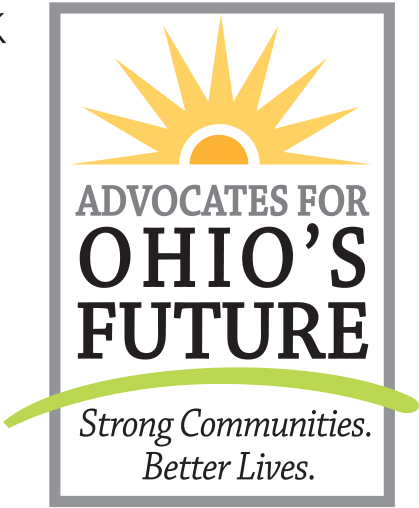Advocates for Ohio’s Future
2025 Budget and Policy Initiatives
Advocates for Ohio’s Future (AOF) is a nonprofit, nonpartisan coalition of state and local health and human services policy, advocacy and provider organizations that strive to strengthen families and communities through public funding for health, human services, and early care & education. We work to empower and support nonprofit organizations and the health and human service workforce in the critical work they do, especially as it relates to lifting up and caring for all Ohioans.
Every day, Ohioans struggle to afford to put food on the table, cover increasing housing costs, pay bills, and support their families. As of 2021, the most recently available data, 13.4% of Ohioans live in poverty and 19% of Ohio children are growing up in poverty. 39% of Ohioans live in a child care desert, and 59% of parents who are not working full-time report they would do so if child care was more affordable. More than 75% of Ohio households receiving Supplemental Nutrition Assistance Program (SNAP) benefits had at least one person working at least part-time in 2021. And a family of two adults with two school-aged children in Ohio would need to earn at least 187% of the federal poverty level to make ends meet.
Data like this shows Ohioans that are able to work are working – but our current system of supports isn’t working for them or their neighbors who aren’t able to work due to age, disability or caregiving responsibilities.
AOF and our member organizations work everyday for a future where every Ohioan lives in safe, affordable housing, has continued access to healthy food, and is able to afford health care and preventive care, leading to better health outcomes.
To create an Ohio with a healthy, thriving workforce that is the best place to live, raise a family, work, retire, and age, AOF will lead advocacy to:
Invest in healthy futures for Ohio’s children today – the workforce of tomorrow
Improve maternal and infant health outcomes by funding and supporting evidence-based programs, including Healthy Beginnings at Home and moving WIC benefit loading online
Ensure a healthy start in life by increasing Medicaid eligibility for pregnant women and children in families earning up to 300% FPL and extending continuous coverage for children up to six years old
Eliminate lead poisoning in Ohio through prevention, remediation, and comprehensive health screenings for kids
Invest in universal, healthy no-cost school meals for all students so Ohio youth can focus on learning
Strengthen work supports and address benefits cliffs to promote economic mobility and security
Reward work and support low-income families on the path to prosperity by making the state Earned Income Tax Credit (EITC) refundable at 10% of the federal credit
Help Ohioans access needed help and work supports by ensuring adequate funding for County Departments of Job and Family Services in order to focus on transformational case work
Expand initial Publicly Funded Child Care eligibility to 200% FPL and invest in the child care workforce through increased wages, job quality, and job retention.
Advance programs that allow older Ohioans to age in place with dignity
Enhance Supplemental Nutrition Assistance Program (SNAP) benefits for older adults without earned income by creating a state-funded minimum benefit of $50 per month
Increase the Adult Protective Services line item
Support older Ohioans through Senior Community Services and other flexible funding
Expand investments in home modification to allow more Ohioans to age in place, while also addressing homelessness and housing insecurity among older adults
AOF also joins with our member and partner organizations in supporting policy and budget solutions that will:
Protect Ohio’s fiscal stability to ensure the state maintains consistent funding sources for vital health and human services.
Create a state-funded line item for the statewide implementation of 211 services, which provide an opportunity for individuals to connect with experts 24/7 and receive referrals to crucial help and resources, ranging from housing, food assistance, healthcare, and more.
Fully fund the Fair School Funding Plan.
Strengthen OhioRISE and improve care coordination and administration, including increased data and public reporting. Success must be measured through benchmarks for family satisfaction with services and the number of new Intensive Home-Based Treatment, Functional Family Therapy/Multisystemic Therapy, and respite care services created.
Increase funding to county Family and Children First Councils to $105,000 per council to allow for 1.5 FTEs in each county to support the youth-serving systems collaboration, service coordination, and High-Fidelity Wraparound services FCFCs provide.
Fully fund investments in statewide emergency hunger relief through Ohio’s foodbanks and invest in programs to create Hunger-Free Campuses.
Continue and increase investments in School-Based Health Care in underserved communities.
Implement a long-term sustainability model for home and community-based services wage increases across behavioral health, aging, and disability services, including indexing to keep pace with inflation and other economic factors.
Invest in the health care and direct care workforce, including pipeline programs to develop future workers, job retention programs to retain the current workforce, and invest in job training, job quality, and a Mental Healthcare entry-level credential. Support the Ohio Primary Care Workforce Initiative to increase recruitment and retention of primary care providers in areas with limited access to primary care.
